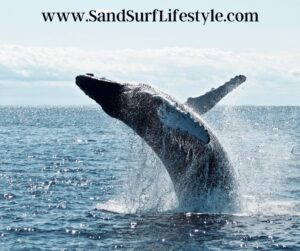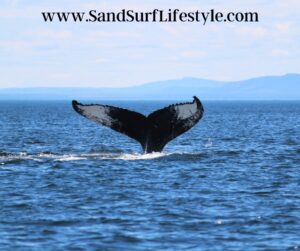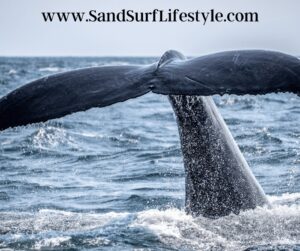If you’ve ever tried to use binoculars to watch whales, you may have found that their magnification wasn’t high enough or that they were too difficult and cumbersome for watching for long periods of time. A spotting scope utilizes a tripod making whale watching easier and less cumbersome.
If you are interested in whale watching, but you aren’t sure what spotting scope you would like to buy, keep reading! We’ll explain each spotting scope in greater detail below. We’ll also explain how to choose your first spotting scope and what some of the spotting scope features mean.
Best Value Scope
The spotting scope with the best value is the Gosky 20-60×80 BAK 4 spotting scope. It packs a mighty punch for a low price with its high zoom range of up to 60x magnification. Many lower-cost spotting scopes reduce the magnification range, but not so with this Gosky. It’s also waterproof and has a digital cell phone adapter making it a great value!
Pros:
 ● Magnification up to 60x
● Magnification up to 60x
● Waterproof
● Digital cell phone adapter
● Good price for value
● Includes a tabletop tripod
Cons:
● Fuzzy image at high zoom
● Not good for moving objects
Why We Like It
The Gosky 20-60×80 BAK 4 spotting scope is great for someone who wants to try out a spotting scope but doesn’t have a lot of money to spend. The higher magnification will allow for viewing up to 800 yards away. While the Gosky spotting scope has little eye relief, making it difficult for users with glasses to look through it, it sports an adapter for use with a cell phone. This allows for a smartphone to be attached to the scope for viewing and taking pictures.
Best Mid-Range Scope
The Vortex Viper HD 20-60×85 Spotting Scope has a more mid-range price than some of the others we’ll showcase today. It has excellent image clarity and is useful for watching a variety of subjects due to its ultra-smooth helical focus. It has a lot of extra features like its built-in sunshade that will make viewing easy and fun.
Pros:
● Reflective coating
● Built-in sunshade
● Adjustable eye-cup
● Waterproof
● Non-slip grip
Cons:
● More expensive
● No included tripod or extras
● Blurry image at full magnification
Why We Like It
The Vortex Viper HD has a wonderful set of features including the built-in sunshade to make it easier to see in the bright light, as well as a multi-position eye-cup making viewing more comfortable for longer periods. Because it’s waterproof and fog proof, it’ll make viewing even in rainy conditions possible. Best of all, it has a non-slip grip to prevent dropping, which is ideal if you plan to use it in many different weather conditions.
Best Scope for Beginners
The Vanguard Endeavour HD 82A is a great spotting scope for beginners due to its ergonomic design, comfortable eyepiece, and low price. Plus it’s lightweight making for easy movement and it’s covered by a lifetime warranty.
Pros:
 ● Multi-Guard coatings
● Multi-Guard coatings
● Lightweight
● Lifetime warranty
● Ergonomic design
● Extra low dispersion glass
● Budget-friendly
Cons:
● Image blurry around the edges
Why We Like It
Any beginner to whale watching shouldn’t feel like they should have to drop $1000 to get started in a new hobby. This scope is perfect for a beginner because of its lightweight, ergonomic design making it easy to use and comfortable. Because it’s backed by a lifetime warranty, a beginner shouldn’t be worried about taking it outdoors and getting tons of use out of it. We recommend you get a sturdy tripod to go along with your spotting scope to get the most out of it!
Looking for some Winter beach activities? Here are 15 fun things to do.
Best Mini Scope
The Celestron Hummingbird is the first micro-spotting scope with many advantages, including its lightweight design. Because of its small design, it’s easy to carry around in a pocket or backpack making it ideal to take with you everywhere.
Pros:
● Small, lightweight design
● Waterproof
● Multi-coated lens
● Helical focus dial
● Can use astronomy lenses
Cons:
● Only 27x magnification
● Low-quality image at the highest magnification
Why We Like It
A small micro-spotting scope is perfect for someone looking to spot things on the go. While this scope can’t be used for ultra-long distances, it’s ideal for anyone wanting to be able to quickly focus with its helical focus dial. Because it can use a variety of other lenses and attach to a smartphone, it’s very versatile despite its small size. Plus, since it’s so lightweight, it’s not strictly necessary to use a tripod with this spotting scope, although it’s still recommended.
Best High-End Scope
The Nightforce TS-80 is one of the best high-end scopes due to its fully weatherproof, high-quality design. It even has a hydrophobic coating that keeps it from getting dirty and staying wet. This scope has been rated as being practically indestructible due to its magnesium alloy body.
Pros:
 ● Magnesium body
● Magnesium body
● Large focus ring
● No image distortion
● Crystal clear images
● Extra low dispersion glass
● Hydrophobic coating
● Waterproof
Cons:
● No extras
Why We Like It
We like this scope for its hand-checked quality and optimally precise glass. This scope is sure to give razor-sharp images. Because of the hydrophobic coating, you won’t experience smudges and fingerprints in your view. Due to its near indestructibility, you won’t have to worry about it breaking. It has even been shock tested to ensure its durability. Lastly, it’s extremely fast making it easier to find your target without missing the opportunity.
How to Choose Your First Spotting Scope
Choosing your first spotting scope can be daunting with so many choices and such a wide variety of features and prices. You might even be wondering why you should choose a spotting scope over binoculars. We’re going to cover the most important aspects of choosing your first spotting scope.
Spotting Scopes Vs. Binoculars
Binoculars can be great for a first-time whale watcher. The main difference between a spotting scope and binoculars is the range of distance and image clarity that you can see when whale watching. With binoculars, you might be able to see a whale’s fin, whereas with a spotting scope you can take pictures of the whale in a close-up view.
Furthermore, binoculars require using your hands and can be heavy making whale watching for long periods difficult and exhausting. A spotting scope can be attached to a sturdy tripod making it easier to watch whales for a longer period of time. Plus, you can choose between an angled or straight spotting scope for the most comfort, depending on your preferences.
Magnification
Magnification is one of the first things you should look at when you choose a spotting scope. Magnification determines how close-up your target will appear when you are looking at it through the scope. The vast majority of spotting scopes start with 20x magnification and vary as to how high they go, but they generally range as high as 60x magnification. 20x magnification should be enough for you to see your target while you are searching the area and 60x magnification should be more than enough for you to see your target in much higher detail.
Lens Size
Your lens size is important too. You can find this number by looking at the magnification and after you see 20-60x, you’ll usually see an mm designation. This is your lens size. Bigger lenses are useful for letting in more light, but the size of the lens directly correlates to the weight of the scope. So depending on how heavy you want your scope to be, you’ll need to determine what size lens you want.
Also, the amount of light that is let into your scope determines your image clarity and how wide your field of view is. So opting for a larger lens size will allow you to see better and capture better images. You’ll have to factor in what size lens you want with how heavy you want your scope to be, as well as how much you can afford to spend.
Glass Quality
Glass quality is what determines how clear the image is when you see it. Cheaper glass leads to chromatic aberrations, which is basically where the colors are distorted. As you can imagine, this isn’t ideal when you are trying to get clear images of a whale from a long distance away. As a result, you’ll want to get the best glass quality that you can afford. Some lenses have extra-low dispersion glass, which will help prevent those chromatic aberrations.
Additional Tips
Select a spotting scope with an eyepiece that will have comfortable relief for you. Some spotting scopes come with an adjustable eyepiece, which will make viewing more comfortable. Since you’ll be spending hours of your time looking through this scope, you’ll want it to be as comfortable as possible.
You’ll also want to look for a scope that can support a camera or smartphone if you are hoping to take pictures with your scope. Otherwise, you won’t be able to share images of the things you see. This is entirely dependent on what your intention for using the scope will be.
Lastly, you should pick up a tripod. Most spotting scopes are really too heavy to use without a tripod comfortably. Not only that but, you’ll want to be able to comfortably view your target for a long period of time without tiring out. If you don’t have a tripod, your arms will get tired after holding the scope for so long. You should use a tripod even if you can comfortably hold the scope for a long period of time because it’s easier to focus on an image with the scope stable atop a tripod. It’s much harder to zoom in and focus on your target without a tripod.
Please note: This blog post is for educational purposes only and does not constitute legal or medical advice. Please consult a legal expert or medical professional to address your specific needs.

